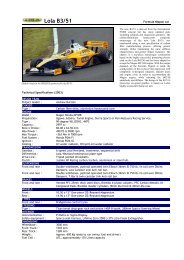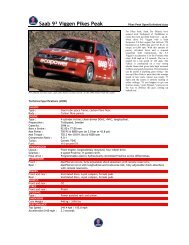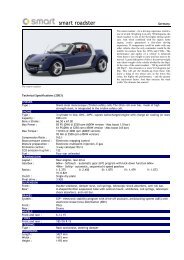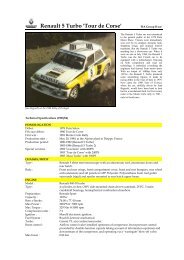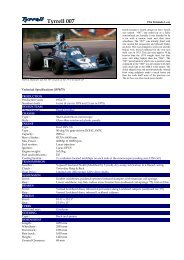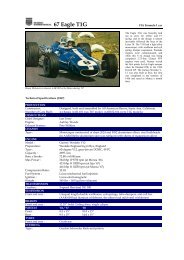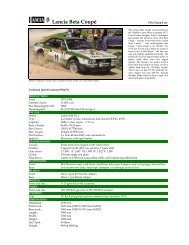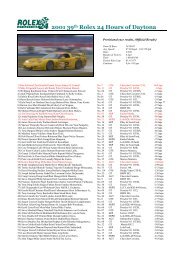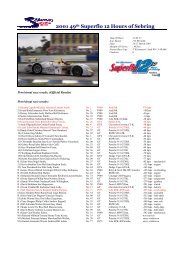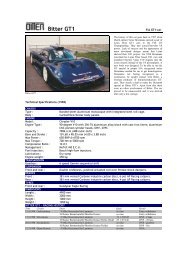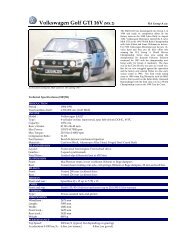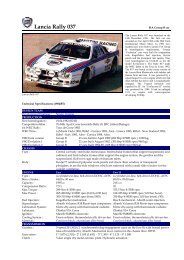70 Chaparral 2J - Motorsports Almanac
70 Chaparral 2J - Motorsports Almanac
70 Chaparral 2J - Motorsports Almanac
You also want an ePaper? Increase the reach of your titles
YUMPU automatically turns print PDFs into web optimized ePapers that Google loves.
EOIN YOUNG TALKS TO VIC ELFORD ON DRIVING THE CHAPARRAL 19<strong>70</strong><br />
Currently the most controversial car on the CanAm sports car scene, the <strong>Chaparral</strong> <strong>2J</strong> ground effect car—or the " super<br />
sucker " or "vacuum cleaner" as it has been christened— has yet to finish a race. The controversy has been sparked off in<br />
CanAm by the alarming potential of the new car, which uses an auxiliary engine to drive suction fans which help to<br />
create a partial vacuum under the car, thereby "sucking" it down on to the road. The car first appeared at Watkins Glen<br />
in July with the then world champion, Jackie Stewart, at the wheel for his only appearance in the CanAm series. He set<br />
fastest lap in the race before the auxiliary 750 cc JLO two-stroke engine failed. With the exception of Laguna Seca, where<br />
the 8-litre Chevy engine blew up at the end of practice, the little JLO has always been the main problem with the<br />
complex new car. In the final race at Riverside, with the threat of protests and official SCCA banning hanging over the<br />
<strong>Chaparral</strong>, Elford qualified the car 2.2 secs faster than Denny Hulme's title-winning M8D McLaren. Through Riverside's<br />
Turn 9 loop at the end of the long straight the <strong>Chaparral</strong> was a clear half-second faster than the McLaren. "The big<br />
difference between the <strong>Chaparral</strong> and a conventional sports car like a 917 Porsche or anything else I've driven before, is<br />
this unreal sensation of being glued to the road," says Vic Elford. "Just to explain that a little, the partial vacuum that is<br />
created underneath allows the air pressure to work a little harder on the car, so that in effect the car has a down-force or<br />
loading on it of something like 1000 lbs over the weight of the car. Driving through a corner it has this much extra<br />
weight acting on the wheels. "As you start to approach the 'limit of adhesion on braking or cornering with a<br />
conventional racing car, whether it's a single-seater or a sports car, it starts to get a little bit out of shape. It will start to<br />
twitch a bit. The back starts to go from side to side, and the driver is kept busy at the wheel. With the <strong>Chaparral</strong>—at<br />
least at the stage I've reached with it—this just doesn't happen. When you want to go through a corner you simply turn<br />
the wheel and the car goes round as though it’s on rails. " I'm now beginning to get to the stage on some corners where I<br />
am reaching the limit, but even when this happens it's quite undramatic compared with a normal car. It just starts to<br />
slide out a little. In a faster corner the back starts to come out, but it really floats rather than slides, and I don't have to<br />
start twitching the wheel to hold it. I take off perhaps half an inch of lock, and the car remains in its smooth line through<br />
the corner. "The same thing is true under braking. I can brake considerably later than most cars on the way into corners<br />
because the car is so very firm and stable on the road. If I make a mistake, as I have done once or twice with the car on<br />
the approach to a corner and I enter it too fast, I can put the brakes on and start to slow it down when I'm on the way in<br />
or halfway through a corner. With a normal car if you started to do something like that, the chances are that you would<br />
lock a wheel instantly, if only for a fraction of a second, and slide off the road." This season CanAm fields have averaged<br />
27 cars, and with only perhaps half a dozen competitive machines there is a definite problem with slow traffic. Denny<br />
Hulme complained earlier in the season that the leaders were having to set their pace to that of the slowest car to avoid<br />
being run off the road while negotiating the tail-enders. In this respect, Elford was fortunate with the <strong>Chaparral</strong>. " The<br />
car is just so good in traffic. In any race you encounter slower cars as you get on through the event, and passing them<br />
with any normal car is often quite a problem because they tend to stick to the line and we have to go round the outside<br />
of them. This is where the <strong>2J</strong> shines, because it is so much better than conventional cars when you get it off the accepted<br />
line for a corner." Ask Vic about horsepower from the aluminium Chevy built down in the Midland, Texas, engine<br />
workshops by Gary Knutson, and Vic casts an anxious eye at <strong>Chaparral</strong> boss Jim Hall. Hall tells him to say the car has<br />
<strong>70</strong>0 horsepower and that it's on a par with the rest of the front runners. As with the McLaren team, there is always a<br />
doubt hanging over the CanAm races that perhaps the <strong>Chaparral</strong> team are running larger engines than they claim. This<br />
makes it easy for the slower drivers to excuse their lack of pace. Before Vic drove the car for the first time at Atlanta in<br />
mid-September, he went down to Midland to try the <strong>2J</strong> round Rattlesnake Raceway, Hall's private test track near his<br />
racing workshops. His main preoccupation then was learning to drive the automatic transmission car and braking with<br />
his left foot since there wasn't a clutch to worry about. Anticipating when he would race an automatic car, Elford had<br />
practised left foot braking from the day he took delivery of his automatic Ford Zodiac, but in moments of stress he<br />
tended to forget. "It was a bit dramatic occasionally because I would tramp on the wrong pedal coming up to traffic<br />
lights! When I drove the <strong>2J</strong> at Midland I did have a bit of a problem once or twice as I went to change gear with the<br />
selector lever, particularly changing up. I would tend to stamp on the brake pedal just as I flicked the lever through.<br />
This happened at Atlanta the first time I drove it in practice, but I soon got used to it." At Atlanta, Elford qualified on<br />
pole position, 1.26 secs faster than Hulme in the McLaren. Like the <strong>Chaparral</strong> he drives, "Quick Vic" tends to be a<br />
controversial personality, speaking the truth as he sees and understands it rather than playing the motor racing<br />
diplomat which seems to be vital these days. The facts are often not as important as how they are presented. Through<br />
personal determination and drive, Elford has graduated from a rally navigator to a Monte Carlo-winning rally driver<br />
with Porsche, and thence into top-line international motor racing. His appearances in Formula l to date have not been<br />
remarkable because the cars have tended to overshadow the driver's ability. Elford's plans for 1971 include the full<br />
CanAm Series, perhaps the three major speedway races at Indianapolis, Ontario and Pokeno, and the chance of a Grand<br />
Prix drive as well. He has been talking with Ron Tauranac about a Brabham ride. Elford is 35, wiry at 11 stone, and 'lives<br />
with his wife and family at Heston, only seven minutes from London Airport, which is an important consideration. His<br />
blonde wife Mary accompanies him to all his races. To gain a foothold in CanAm he drove less than competitive cars,<br />
flirted with the way-out knee-high AVS Shadow, and then suddenly appeared on top with the <strong>Chaparral</strong> at Atlanta. "I<br />
enjoy CanAm racing. These two-hour 200-mile sprint races are ideal for the driver, because you keep going pretty well<br />
flat out and you can have a good race for that time. The only criticism I've got about the CanAm Series is that there is so<br />
little competition. I don't mean for us, but with or without the <strong>Chaparral</strong> there are still only four or five cars that are<br />
really competitive. The two McLarens, the L&M Lola, the Autocoast, and that's about where it stops. After that it tends<br />
to become a bit of a procession and people trundle round knowing that they're going to finish somewhere in the money.<br />
In many cases when you get below the top six or seven they don’t race anyway—they're quite happy to drive around<br />
just to finish. The racing would certainly be a lot better if there were more factory entries either from America or from



